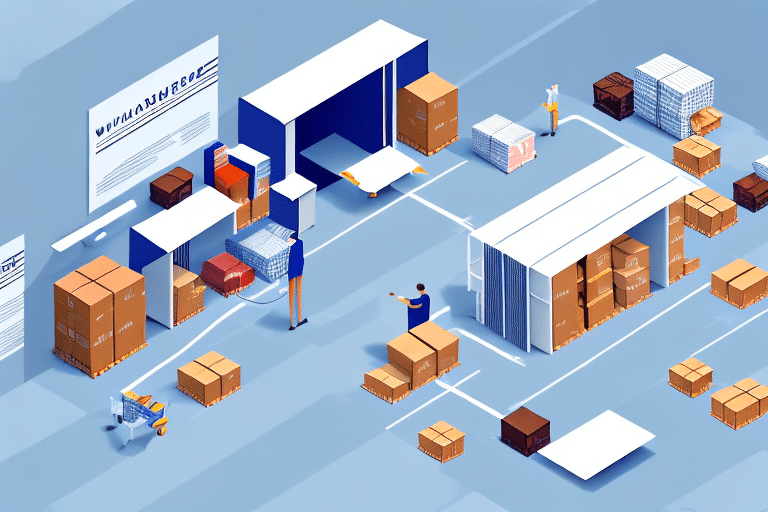Optimizing Ecommerce Order Fulfillment Warehouse KPIs and Metrics: Essential Ecommerce Metrics and KPIs to Know
If you own a business that sells products online, then you're likely acutely aware of the importance of order fulfillment. Whether you're fulfilling orders yourself or outsourcing to a third-party logistics provider, it's essential to have a clear understanding of your ecommerce warehouse's key performance indicators (KPIs) and metrics. That way, you can make data-driven decisions to optimize your order fulfillment process, reduce costs, and improve customer satisfaction. In this article, we'll delve into the essential ecommerce metrics and KPIs you need to know to manage your ecommerce warehouse efficiently.
Understanding the Importance of Ecommerce Warehouse KPIs and Metrics
Tracking and analyzing KPIs and metrics in ecommerce order fulfillment is crucial for achieving optimal performance. According to a McKinsey report, businesses that effectively monitor their fulfillment processes can increase customer satisfaction by up to 20% while reducing operational costs by 15%. These metrics provide valuable insights into everything from inventory management to order accuracy to shipping speed. They reveal the key strengths and weaknesses of your ecommerce warehouse's operations, allowing you to make data-driven decisions that can improve processes, reduce costs, and enhance customer satisfaction.
One of the most important KPIs for ecommerce warehouses is order cycle time. This metric measures the time it takes for an order to be processed, picked, packed, and shipped. By tracking order cycle time, you can identify bottlenecks in your fulfillment process and make adjustments to improve efficiency. Another crucial metric is order accuracy, which measures the percentage of orders that are shipped without errors. Improving order accuracy can lead to increased customer satisfaction and reduced costs associated with returns and exchanges.
Key Performance Indicators for Ecommerce Order Fulfillment
There are numerous KPIs and metrics you can track in your ecommerce warehouse, but some are more critical than others. Here are some of the most important KPIs and metrics to keep an eye on:
- Order cycle time: This metric tracks how long it takes to process and fulfill an order, from the time it's placed to the time it's shipped. Keeping this metric low is crucial for satisfying customers and meeting delivery expectations.
- Inventory accuracy: This metric measures how well you're managing your inventory. An accurate inventory count is essential for avoiding stockouts and overstocking, which can both lead to lost revenue.
- Perfect order rate: This measures the percentage of orders that are delivered on time, in full, and with no errors. Maintaining a high perfect order rate is crucial for customer satisfaction and brand loyalty.
- Warehouse space utilization: This measures how well you're using your warehouse space. Maximizing your warehouse space utilization can help reduce costs and improve efficiency.
- Real-time visibility: This metric tracks how well you're able to monitor your inventory and order fulfillment processes in real-time. Having real-time visibility is crucial for identifying and addressing issues proactively.
Aside from the KPIs mentioned above, there are other metrics that can help you improve your ecommerce order fulfillment process. One of these is the return rate, which measures the percentage of orders that are returned by customers. A high return rate can indicate issues with product quality, inaccurate product descriptions, or poor customer service.
Another important metric to track is the cost per order, which measures the total cost of fulfilling an order, including labor, materials, and shipping. By monitoring this metric, you can identify areas where you can reduce costs and improve efficiency in your order fulfillment process.
Measuring Your Ecommerce Warehouse Performance
Now that you know the key KPIs and metrics to track, it's essential to understand how to measure them effectively. One effective way is to use an ecommerce Warehouse Management System (WMS). A WMS can track and analyze your warehouse data in real-time, providing you with a comprehensive view of your performance. This enables you to identify trends and areas for improvement and take action accordingly. Other tools you can use include spreadsheets and custom dashboards, though automated systems are generally more reliable and efficient.
Another important factor to consider when measuring your ecommerce warehouse performance is the accuracy of your inventory. This can be achieved through regular cycle counts and audits, as well as implementing barcode scanning and RFID technology. According to a study by RFID Warehouse Solutions, implementing RFID technology can improve inventory accuracy by up to 99%, significantly reducing the risk of stockouts and overstocking, which can negatively impact your bottom line.
It's also important to regularly review and optimize your warehouse layout and processes. This can include analyzing your picking routes, storage locations, and order fulfillment methods. By streamlining your processes and reducing unnecessary steps, you can improve efficiency and reduce errors, ultimately leading to a better customer experience and increased profitability.
Tracking Inventory Accuracy: A Crucial Metric for Ecommerce Warehouses
Inventory accuracy is a crucial metric for ecommerce warehouses. An inaccurate inventory count can lead to stockouts or overstocking, both of which can lead to lost revenue. To measure inventory accuracy, you can use cycle counting, which involves counting a small subset of your inventory on a regular basis. This can help you detect discrepancies early on and take corrective action before they become more significant issues.
Another way to improve inventory accuracy is by implementing an inventory management system. This system can help you track inventory levels in real-time, automate reordering processes, and provide insights into inventory trends. By having a better understanding of your inventory, you can make more informed decisions about purchasing, stocking, and selling products.
It's also important to train your warehouse staff on proper inventory management procedures. This includes how to accurately count inventory, how to handle and store products, and how to use any inventory management software or tools. By investing in proper training, you can ensure that your inventory accuracy remains high and that your warehouse operations run smoothly.
The Vital Role of Order Cycle Time in Ecommerce Fulfillment
Order cycle time is another critical metric for ecommerce warehouses. It measures how long it takes to process and fulfill an order, from the time it's placed to the time it's shipped. A high order cycle time can lead to customer frustration and lost revenue. To reduce order cycle time, you can implement an order management system (OMS), automate processes, and simplify your order processing workflows.
One of the main reasons why order cycle time is so important is because it directly impacts customer satisfaction. In today's fast-paced world, customers expect their orders to be processed and shipped quickly. If they have to wait too long, they may become frustrated and choose to shop elsewhere. According to a Statista report, over 60% of customers consider fast delivery times to be a significant factor in their purchasing decisions. By reducing order cycle time, you can improve customer satisfaction and increase the likelihood of repeat business.
Another benefit of reducing order cycle time is that it can help you stay competitive in the ecommerce industry. With so many online retailers vying for customers' attention, it's important to offer fast and efficient order fulfillment. By streamlining your processes and reducing order cycle time, you can stand out from the competition and attract more customers to your business.
Reducing Shipping Costs: An Important KPI for Ecommerce Warehouses
For ecommerce warehouses, shipping costs can be a significant expense. To reduce shipping costs, you can negotiate shipping rates with carriers, optimize your packaging, and evaluate your shipping strategy regularly. Tracking your shipping costs and identifying trends can also help you optimize your fulfillment process and reduce costs.
Another effective way to reduce shipping costs is to consider using a third-party logistics provider (3PL). A 3PL can help you consolidate shipments, negotiate better rates with carriers, and provide expertise in optimizing your shipping strategy. According to a Nasdaq article, outsourcing your fulfillment to a 3PL can lead to cost savings of up to 20%, while also freeing up your time and resources to focus on other aspects of your ecommerce business, such as marketing and customer service.
The Significance of Perfect Order Rate in Ecommerce Order Fulfillment
Perfect order rate is a measure of the percentage of orders delivered on time, in full, and with no errors. Maintaining a high perfect order rate is crucial for customer satisfaction and loyalty. To improve your perfect order rate, you can implement quality control measures, automate order processing, and use inventory management software to avoid stockouts and overstocking.
Maximizing Your Warehouse Space Utilization: A Key Metric to Watch Out For
Warehouse space utilization is a metric that measures how well you're using your warehouse space. Maximizing your warehouse space utilization can help you reduce costs and increase efficiency. To maximize your warehouse space utilization, you can use vertical storage, optimize aisle widths, and use a slotting system to ensure your most popular products are within easy reach.
The Importance of Real-Time Visibility in Ecommerce Warehousing Operations
Real-time visibility is the ability to monitor your inventory and order fulfillment processes in real-time. Having real-time visibility is crucial for identifying and addressing issues proactively. To achieve real-time visibility, you can use a WMS, implement barcode scanning, and automate inventory tracking.
Identifying and Addressing Bottlenecks in Your Ecommerce Fulfillment Process
Bottlenecks in your fulfillment process can lead to delays, errors, and customer dissatisfaction. To identify and address bottlenecks, you can analyze your KPIs and metrics, map out your workflows, and use process improvement methodologies like Lean Six Sigma. Addressing bottlenecks can help you increase efficiency and reduce costs.
Leveraging Technology to Improve Your KPIs and Metrics in Ecommerce Warehousing
Technology can be a powerful tool for improving your KPIs and metrics in ecommerce warehousing. Using a WMS, order management system (OMS), and barcode scanning can help you automate processes, increase efficiency, and reduce errors. Other technologies worth exploring include robotics, artificial intelligence, and machine learning, which can further enhance your warehouse operations.
Building a Customized Dashboard for Monitoring Your Warehouse KPIs
A customized dashboard can be an effective tool for monitoring your warehouse KPIs. A dashboard can visually summarize your data and provide you with a quick and easy way to see how well you're performing and where you need to focus your efforts. To build a customized dashboard, you can use data visualization tools like Tableau, Power BI, or Google Data Studio.
Common Challenges in Measuring KPIs and Metrics for Ecommerce Warehousing Operations
Measuring KPIs and metrics in ecommerce warehousing operations comes with its own set of challenges. These include data accuracy, data quality, and resistance to change among staff. To overcome these challenges, you can invest in training, use automated tracking tools, and focus on continuous improvement. Ensuring high-quality data collection and fostering a culture that embraces data-driven decision-making are essential steps toward successful KPI management.
Steps to Take When Your KPIs and Metrics Indicate Problems with Your Fulfillment Process
When your KPIs and metrics indicate problems with your ecommerce warehouse's fulfillment process, it's essential to take action quickly. Some steps you can take include:
- Analyze the data: Identify which metrics are underperforming and understand the underlying causes.
- Identify the root cause: Use techniques like the 5 Whys or fishbone diagrams to determine the root cause of the problem.
- Implement corrective action: Develop and execute a plan to address the identified issues, whether it involves process changes, additional training, or technology upgrades.
- Measure the impact: After implementing corrective actions, continue to monitor your KPIs to ensure that the changes are having the desired effect.
It's also beneficial to document these processes and create a feedback loop to prevent future issues and foster a culture of continuous improvement.
Conclusion
Optimizing ecommerce warehouse KPIs and metrics is essential for running a successful online business. By tracking and analyzing essential KPIs and metrics like inventory accuracy, order cycle time, and perfect order rate, you can make data-driven decisions that can improve processes, reduce costs, and enhance customer satisfaction. Leveraging technology, building custom dashboards, and addressing bottlenecks can also help you achieve optimal performance. Ultimately, by focusing on your KPIs and metrics, you can optimize your ecommerce order fulfillment process and take your business to the next level.




















